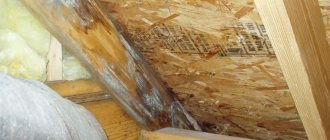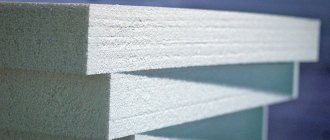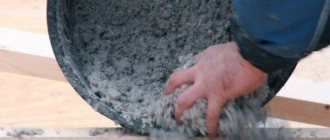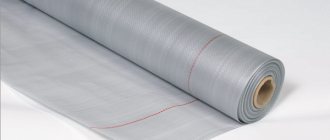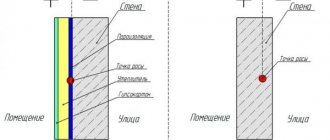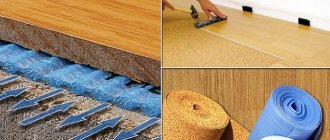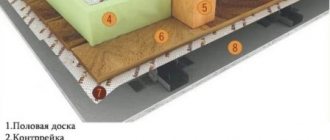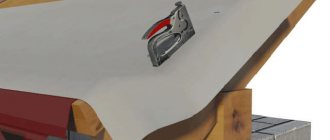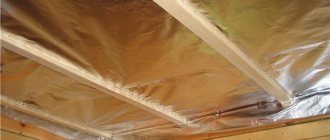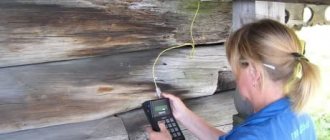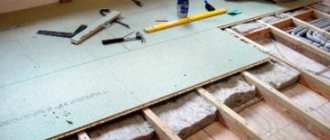When forming a heat-insulating layer, vapor barrier of the insulation is performed to prevent wetting caused by domestic steam condensate. Suspended water particles leave the room in the form of steam if the insulation is insulated from them. It will get wet, lose its thermal insulation qualities and, as a result, shrink. Despite this, vapor barrier has a negative property. To maintain an optimal level of humidity in the room, it is necessary to use an air conditioner or frequently ventilate the house.
Ecowool, three-quarters consisting of ordinary paper, forming a capillary-porous structure, is not afraid of penetrating moisture. Compared to mineral insulators, where moisture forms in the cavities between the fibers, ecowool accumulates moisture using capillary fibers. Just like a paper napkin easily allows water to pass through, the breathable ecowool material allows steam particles to pass through and regulates indoor humidity without losing heat-protective characteristics.
Summarizing all of the above, it should be noted that in the vast majority of cases, when insulating houses with ecowool, a vapor barrier is a priori not needed. This principle does not apply to premises with a prevailing high level of humidity - swimming pools, car washes, baths and saunas. The decision to vapor barrier the listed premises is always made on an individual basis. In today's article we will talk about the hygroscopic properties of thermal insulating cellulose wool.
Research part
The object of study within the framework of this material is the thermal insulation material ecowool made from primary cellulose. The primary objective of the study is to determine the hygroscopic properties of cotton wool under positive and negative temperatures, varying from +20 to 40 degrees Celsius with a minus sign. The second task is to conduct a comparative analysis of the hygroscopicity of wool without mineral additives with ecowool and build sorption isotherms. Based on the data obtained, formulate scientific conclusions about the possibility of professional use of insulation as a thermal insulation material for the arrangement of civil and industrial construction projects.
From the upcoming research article you will learn about the results of previously conducted experiments on sorption-desorption isotherm graphs of ecowool samples and wool without mineral additives. Get acquainted with the results of mathematical processing of the isotherm at a temperature of 10 degrees Celsius with a minus sign according to the Frenkel-Halsey-Hill equation, hereinafter abbreviated as FHH. Obtain information about changes in the thermal capacity of ecowool samples with different water content using the example of a calorimetric circuit. Based on information about the vapor permeability of the outer wall made of red brick and the inner layer of ecowool, you will learn about the calculated entrainment and accumulation of water at the boundary of the two layers in the conditions of the Krasnoyarsk region.
Ecowool floor insulation technology
As a rule, the floor design with some non-fundamental differences looks like this:
- The base of the floor is filled with concrete mortar or remains earthen;
- Next, the subfloor is made up of wooden logs;
- The bottom side is lined with a vapor barrier film (this option is required if the floor is earthen);
- The underside of the subfloor can be additionally covered with a layer of moisture-resistant plasterboard;
- Ecowool is manually poured on top without tamping (see below for the mechanical method of blowing);
- A finishing layer of floorboards, OSB, DSP or laminate is laid on top of the wooden logs and insulation;
- When mechanically blowing ecowool, special technological holes are used in the floor, which has already been laid with the top finishing layer. After the insulation is blown into the cavity between the joists, the technological holes are closed.
This technology allows for seamless insulation of the floor of a country house. Ecowool fills the entire space, covering all communications and electrical cables laid along the base of the floor. After insulation, there are no gaps left between the communication elements and the floor.
Ecowool belongs to the G-2 flammability class and, if wiring in the floor catches fire, it prevents the spread of fire, since it does not burn, but smolders.
Cellulose insulation is not suitable for insects and rodents due to their intolerance to the natural component - borax. This gives the home additional comfort and sanitary safety.
Selection of equipment for installation of ecowool
Before laying, the raw materials must be fluffed to a uniform consistency. Only in this state does it have the necessary insulating characteristics. Mechanization of the process involves the use of special devices that automatically loosen the material and supply it along with air through the pipe to the ceiling.
A typical blow molding device design looks like this:
- Platform on which the engine, gearbox, blower and other components are mounted.
- Electric motor with gearbox - can be two or three stages. This scheme allows the buyer to choose products based on performance and power. Typically, the power plant operates on a low current, which ensures the machine is silent and durable.
- Gateway - designed to capture cotton wool and fluff it up. From it the working mass is fed into the hose.
- Funnel - for loading material into the device.
- Damper - allows you to regulate its flow into the gateway.
- Baking powder - fluffs the compressed substance.
- Remote control - to control the installation. In many products, you can change the speed of movement of biomass and its supply remotely.
- Emergency switch - for quickly stopping the machine.
There are several classes of blow molding machines that differ in performance. Professional devices include devices that pump at least 700 kg of substance per hour. They have the greatest degree of mechanization of the process. Semi-professional models allow you to blow out about 80 ecowool bags. Budget options are designed for a small amount of work. In such machines, the material is loosened and fed to the turbine manually.
Instead of factory-made blowers, you can use homemade devices. For example, a garden blower of the Elitech BC 2000 model is suitable for this purpose, but with minor modifications.
To prepare it for use, perform the following operations:
- Move the terminals from one part of the product to another to increase the power of the device.
- Remove the teeth on the dust collector pipe. If you don't touch them, the cotton wool will cling and clog the hose.
- Connect the corrugation to the hole in the device and secure with tape. Buy a hose with a diameter of 63 mm and a length of 7 m.
- Put a thick cloth glove on the pipe and cut off the part with the fingers. It is used to seal the gaps between the hose and the hole in the floor to prevent fibers from being sprayed into the room.
Selection of materials for floor insulation
Before insulating the floors in your house with ecowool, decide on the thickness of the insulating layer. You can choose it according to our recommendations:
- A thickness of 10-15 cm is sufficient to prevent heat leakage on interfloor ceilings. In the northern regions it is increased to 20 cm.
- The floor of a non-residential attic and attic is insulated with a layer of 30-40 cm. The increase in the heat-insulating layer on the upper floor is due to the fact that warm air rises and the greatest losses will be in the attic.
When manually filling, the permissible density of the material is 30-35 M3, when blowing it is 40-45 M3.
To calculate the exact amount of raw materials, multiply the floor area, the thickness of the layer and its density. Select the last parameter 45 kg/m3.
Calculation example: if the area is 20 m2, the layer thickness is 0.2 m, then ecowool for the floor will need 10 × 0.2 × 0.45 = 90 kg. By finding out the weight of one bag from the seller, you can determine their number.
The material does not have GOST standards for production, so the composition of the insulation differs from different manufacturers. It is not possible to check whether the actual characteristics correspond to those stated at the time of purchase; the quality of the product can only be assessed visually.
Useful recommendations when choosing ecowool:
- Outwardly, it looks like fluff made up of small fragments. They should not feel like cut paper or powder to the touch.
- When shaking, finely dispersed elements do not spill out of the workpiece.
- Do not buy a product with large parts; they are poorly saturated with protective agents.
- When you try to light the ecowool, it smolders for a short time and goes out.
- The material must be stored in protective original packaging.
- Buy only dry fibers.
- The normal color of insulation is gray. A yellow or light tint means that it contains low-quality raw materials. In most cases, deterioration in performance properties occurs due to savings on the most important components - borates.
- Find out what fire retardant was added to the product. Borax or borax is considered acceptable. If ammonium sulfate with boric acid is present, then after installation a strong unpleasant odor will appear in the room. In addition, raw materials with such inclusions quickly lose their quality.
It is advisable to use products from trusted manufacturers. Before purchasing a product with an unknown logo, it is recommended to collect as much information as possible about the manufacturer. Information of interest can be found on construction forums.
Reputable companies that deal with ecowool include:
- Ekovilla, Tertech are Finnish manufacturers that have been supplying products to the Russian market for more than 30 years.
- Isofloc is a German company that sells the highest quality products all over the world.
- In Russia we can highlight (Moscow region), “Ekovata” (Chuvash Republic), and Don Industrial. In these companies, products are manufactured using equipment with automatic dosing of components. This technology guarantees the stability of the heat insulator.
Manual laying of ecowool on the floor
This method is recommended to treat the floors of small rooms when the use of blowers is not economically feasible. Logs should be fixed to the base, preferably with jumpers for better compaction. If the work is being done in a residential building, remove the flooring boards, because ecowool is only laid on top of the floor.
The fibrous mass is not afraid of high humidity, but no one forbids covering the base with a waterproofing film.
The minimum depth of a cell for insulation can be determined based on the requirements for its thickness in the previous section. In order not to increase the consumption of the substance, install the subfloor at a given depth.
Perform further work in this order:
- Transfer the required amount of cotton wool into any container with a capacity of more than 50 liters and beat for 5 minutes with an electric drill with a mixer attachment. You can mix it in the same bag you purchased it in. Please note that when fluffed, the substance increases 2-3 times. The finished mass resembles ordinary cotton wool or shavings and keeps in a heap if squeezed into a handful.
- Fill the substance between the beams slightly above the level of the joists. Tamp the material periodically to fill any voids. Otherwise, it will lose some of its insulating properties.
- Process the wool between the joists again with a drill with an attachment. Align the fragments into cells using the rule.
- Moisten the top layer of cotton wool with water from a spray bottle. It activates lignin, which is part of cellulose. Under its influence, the fibers stick together and form a thin crust, which increases moisture resistance and prevents moisture from penetrating inside.
- After a few days, when the coating has dried, cover it with waterproofing film.
- Install the decking and then the flooring.
Mechanized installation of ecowool on the floor
To cover the base using a mechanized method, it is necessary to have a flooring that creates an enclosed space under the partition. Make a hole in the board in an inconspicuous place for the hose of the device.
The technology for insulating floors with ecowool is as follows:
- Insert the hose into the hole, move it all the way to the wall of the room, and then move it half a meter.
- Seal the gap between the pipe and the floor using available materials.
- Place cellulose in the blower container.
- Set the operating mode of the product and turn it on.
- After the space between the pipe and the wall is filled (this is determined by the change in the blowing noise), pull out the hose half a meter and continue feeding the mass under the boards.
- At the last stage, the hose should fit 1 cm into the gap.
- Seal the hole in the floor.
Blower devices can be used even with an open insulation method. But it will not be possible to create the required density by feeding it from a hose, so from time to time the material has to be pressed manually.
If you are using a homemade device, grab the fibers little by little, otherwise the power of the device will not be enough to move the mass.
The above methods of laying cellulose and its characteristics show that the material is no worse than traditional heat insulators, and in terms of environmental friendliness and waste-freeness it has no equal. If you are insulating the floor with ecowool yourself, study the features of the process and determine which method of application is economically beneficial for you.
Introductory part
The use of ecological cellulose wool as a heat-insulating building material in the conditions of the Western Siberian region requires a thorough study of the hygroscopic qualities. At the moment, there is no information about the technical characteristics of ecowool as a natural insulation that absorbs moisture at low positive and negative temperatures in Siberia. In this regard, it is necessary to fill the missing knowledge about the above-mentioned hygroscopic properties of recycled cellulose wool containing borax and boric acid as additional components.
Ecowool insulation
Thermal insulating wool made from recycled paper is actively used as insulation of houses inside and outside by residents of European countries. Residents of Germany, Austria, France and other regions successfully use it to insulate villas, cottages, as well as industrial buildings and structures. However, in the harsh Western Siberian climate, problems may arise in creating an internal layer of thermal insulation (without vapor insulation). At low temperatures outside the window, a temperature gradient from +20 degrees Celsius in a room with a relative humidity level of 55% to zero degrees and below at the border with the wall can form in the heat-insulating layer of ecowool.
Under the conditions mentioned above, in the layers of the insulation under consideration (ecowool) with a relatively low temperature, the possibility of condensation of water vapor under the article of volumetric capillary formation is not excluded, exceeding the potentially permissible limits of the ecowool moisture level. If there is excessive accumulation of water under conditions of a temperature drop to negative values, an ice crust may even form in the ecowool layer adjacent to the wall. In order to determine safe conditions for the active use of cotton wool from cellulose raw materials from the considered point of view, in addition to the characteristics that have been established to date and necessary for calculations, it is necessary to have information about the characteristics of liquid sorption by ecowool.
Unlike the vast majority of heat-insulating building materials, ecowool insulation has an increased sorption capacity relative to water. This quality significantly brings the announced thermal insulator closer to natural wood. It is this quality of ecowool, as a heat-insulating product, that first of all arouses significant interest, since with its professional use, the most comfortable conditions are achieved inside residential and non-residential premises. Ecowool is actively insulated not only in residential buildings and industrial buildings, but also in large-scale workshops, aircraft hangars on a frame basis, indoor and underground parking lots.
Minvata
Mineral wool is one of the most popular insulation materials due to its relatively low cost and such qualities as low thermal conductivity (heat loss when using this material is reduced quite noticeably), ease of installation, and excellent sound insulation. In addition, mineral wool is not chewed by rodents; bacteria, mold, and fungi do not grow or multiply on it. Naturally, those who intend to insulate the walls of their home have a question: is a vapor barrier necessary when insulating with mineral wool?
Yes, I need it. A vapor-permeable membrane is used. It is laid with the vapor-permeable side on the prepared walls, and wooden slats are attached on top of it, to which the insulation will already be attached.
The membrane removes water vapor from the walls of the house through mineral wool. With this installation method, excess moisture is removed, the insulating material is not destroyed, and the walls of the house “breathe.”
However, if the walls are very smooth, you can attach mineral wool without a vapor barrier film.
